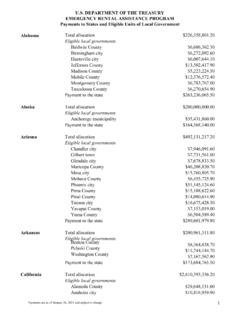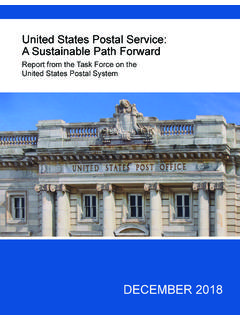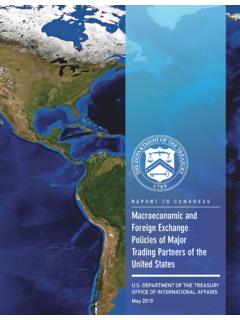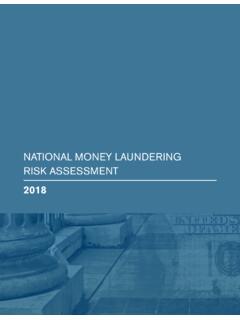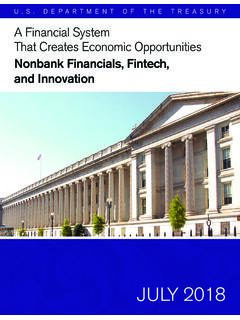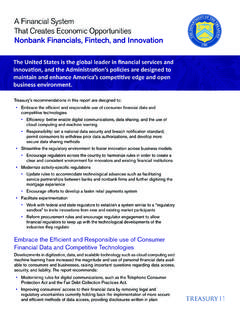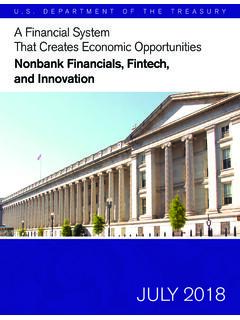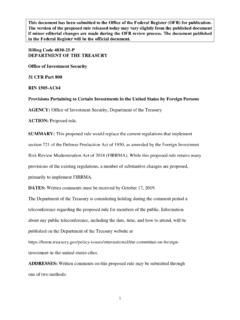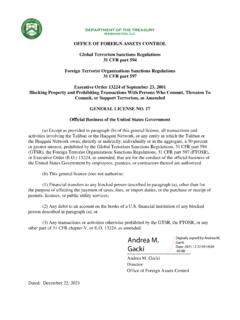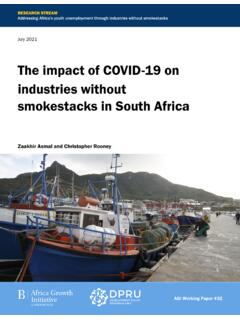Transcription of U.S. Department of the Treasury State Small Business ...
1 1 Department of the Treasury State Small Business Credit initiative Capital Program Policy Guidelines November 10, 2021 Section I. Overview The American Rescue Plan Act of 2021 (ARPA) reauthorized and amended the Small Business Jobs Act of 2010 (SBJA) to provide $10 billion to fund the State Small Business Credit initiative (SSBCI) as a response to the economic effects of the COVID-19 pandemic. SSBCI is a federal program administered by the Department of the Treasury ( Treasury ) that was created to strengthen State programs that support private financing to Small SSBCI is expected to, in conjunction with new Small Business financing, create billions of dollars in lending and investments to Small businesses that are not getting the support they need to expand and create jobs. SSBCI allows states of the United states , the District of Columbia, territories, eligible municipalities, and Tribal governments (collectively, states 2) the opportunity to build upon or create successful models of Small Business programs.
2 ARPA provided for a $ billion main capital allocation, $ billion allocation for Business enterprises owned and controlled by socially and economically disadvantaged individuals (SEDI-owned businesses), $ billion incentive allocation for SEDI-owned businesses, $500 million allocation for very Small businesses (VSBs), and $500 million allocation for technical assistance funding. In the coming weeks, Treasury will announce the availability of technical assistance funding and issue separate guidelines regarding technical assistance and instructions on how to apply. Technical assistance funding will be made available for states , the District of Columbia, territories, and Tribal governments that complete an application for a SSBCI capital program by February 11, 2022, and eligible municipalities that complete an application for a SSBCI capital program by March 11, 2022.
3 Applications for technical assistance will be due on March 31, 2022. All applicants for technical assistance funding must provide a plan that addresses how they intend to provide legal, accounting, and financial advisory services to VSBs and SEDI-owned businesses applying for SSBCI capital programs or other State or federal Small Business programs. These services can be provided either directly or indirectly, by contracting with legal, accounting, and financial advisory firms. The applicant s plan should also address how, if at all, the technical assistance funding may meet the needs of VSBs and SEDI-owned businesses in 1 The SSBCI provisions are codified at 12 5701 et. seq. 2 Hereinafter, unless indicated otherwise, a State means (A) one of the fifty states of the United states ; (B) the District of Columbia, the Commonwealth of Puerto Rico, the Commonwealth of Northern Mariana Islands, Guam, American Samoa, and the United states Virgin Islands; (C) when designated by one of the fifty states of the United states , a political subdivision of that State that Treasury determines has the capacity to participate in the SSBCI; (D) under the circumstances described in 12 5703(d), a municipality of one of the fifty states of the United states to which Treasury has given a special permission under section 5703(d); and (E) a Tribal government, or a group of Tribal governments that jointly apply for an allocation.
4 See 12 5701(10). 2 different communities, including rural communities; communities undergoing economic transitions, including communities impacted by the shift towards a net-zero economy and deindustrialization; communities surrounding Minority-Serving Institutions3; or other underserved communities. Treasury reserves the right to waive or modify any provision of these guidelines. Section II. Eligible Programs SSBCI provides funding for State Small Business lending and investment programs. There are two State program categories: Capital Access Programs (CAPs) and Other Credit Support Programs (OCSPs). CAPs provide portfolio insurance to lenders that make Small Business loans. Portfolio insurance is provided in the form of a separate loan loss reserve fund for each participating financial institution. To enroll a loan in the CAP, both the lender and the borrower must make insurance premium payments to the reserve fund.
5 The State must make a matching insurance premium payment to the reserve fund. The State s matching payment to the reserve fund may be made with the State s allocated SSBCI funds. OCSPs include other programs that provide support for Small Business lending and investment that are not CAPs. These programs include collateral support programs, loan participation programs, State -sponsored venture capital programs, loan guarantee programs, and other similar OCSPs also include qualifying loan or swap funding facilities, which are contractual arrangements between a State and a private financial entity. Under such facilities, the State delivers funds to the private financial entity as collateral; that entity, in turn, provides funding to the State . The full amount resulting from the arrangement, less any fees or other costs of the arrangement, is contributed to, or for the account of, an approved State program.
6 Section III. Main Capital Allocation 12 5702(b) and (c) a. Allocation Formula 12 5702(b) The SSBCI statute, 12 5702(b), sets out a formula for the amount of main capital funds available to states , the District of Columbia, territories, Tribal governments, and 3 Minority-serving institutions are institutions of higher education that serve minority populations and include, but are not limited to, Historically Black Colleges and Universities (as defined in 20 1061(2)), Hispanic-Serving Institutions (as defined in 20 1101a(a)(5)), Tribal Colleges and Universities (as defined in 20 1059c(b)(3)), and Asian American and Pacific Islander Serving Institutions (as defined in 20 1059g(b)(2)). 4 Collateral support programs help viable businesses that are struggling to get credit because the value of the collateral they hold has fallen and provide banks greater confidence in extending credit to these borrowers.
7 Loan participation programs entail risk sharing among financial institution lenders and the participating State . State -sponsored venture capital programs typically entail joint public-private investment programs focused on seeding Small businesses with high-growth-potential. 3 eligible Pursuant to the statute, Treasury allocated funds to all fifty states along with the District of Columbia, the Commonwealth of Puerto Rico, the Commonwealth of Northern Mariana Islands, Guam, American Samoa, and the United states Virgin Islands according to the formula, which takes into account a State s job losses in proportion to the aggregate job losses of all states . Each State of the United states , the District of Columbia, and territory was guaranteed a minimum allocation of percent of the $6 billion allocation for states (not including Tribal governments).
8 Treasury made a separate allocation to Tribal governments based on Tribal enrollment, with a preliminary minimum allocation of approximately percent of the total $500 million Tribal b. Tranching and Deployment 12 5702(c)(1) Pursuant to 12 5702(c)(1), each State that is approved for participation in the SSBCI will receive its allocation of main capital funds in three disbursements as follows: 33 percent, 33 percent, and 34 percent. The transfer of the first 33 percent will occur promptly following the receipt of the fully signed Allocation As a precondition to receipt of the second and third disbursements, the State must, among other things, certify to Treasury that the State has expended, transferred, or obligated 80 percent or more of the prior disbursement of allocated funds to or for the account of one or more approved State programs that have delivered loans or investments to eligible businesses ( , it has deployed such funds).
9 8 The certification must be signed by an official of the State with oversight responsibility for the approved State program(s). The following is a description of these requirements. Funds Expended, Transferred, or Obligated For purposes of determining whether a State has expended a prior disbursement of SSBCI funds, Treasury will generally consider funds expended if the expenses have been paid by or are for an approved State program. Examples of expended funds include: SSBCI funds that have been disbursed to a lender to cover the federal contribution to a CAP reserve fund; SSBCI funds that have been disbursed to a specific borrower (or disbursed to a specific lender as part of a commitment to a specific transaction) as part of a loan participation, collateral support, or direct lending program; SSBCI funds that have been invested in specific Small businesses 5 For ease of reference, the SSBCI website includes information about allocation amounts and allocation methodology for each State , the District of Columbia, territory, Tribal government, and eligible municipality.
10 Please visit for more details. 6 For more information on the Tribal allocation, please see the Tribal allocation methodology publication on Treasury s website. 7 If the State plans to use SSBCI funds as collateral for a qualifying loan or swap funding facility, the entire allocation is available to be transferred in a single lump sum. 8 As part of this certification, the authorizing official for the participating State will be required to certify to Treasury that the participating State is in compliance with all terms of the Allocation Agreement, SSBCI Capital Program Policy Guidelines, and the representations and warranties made in both the Allocation Agreement and the SF-424B (Assurances Non-Construction). Upon receipt, Treasury will review the request and accompanying certification for completeness. Treasury may ask for records or further information that substantiates any aspect of the participating State s certification.
